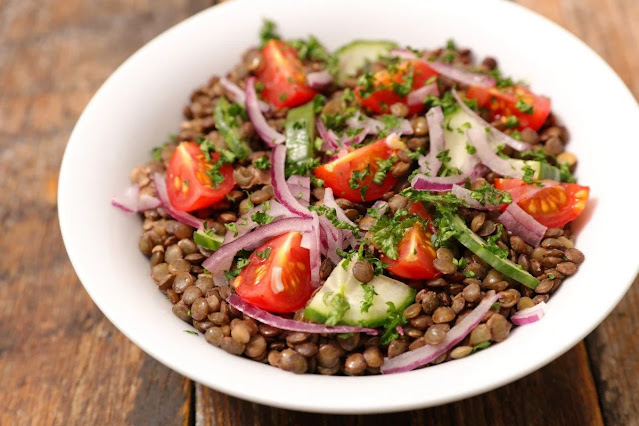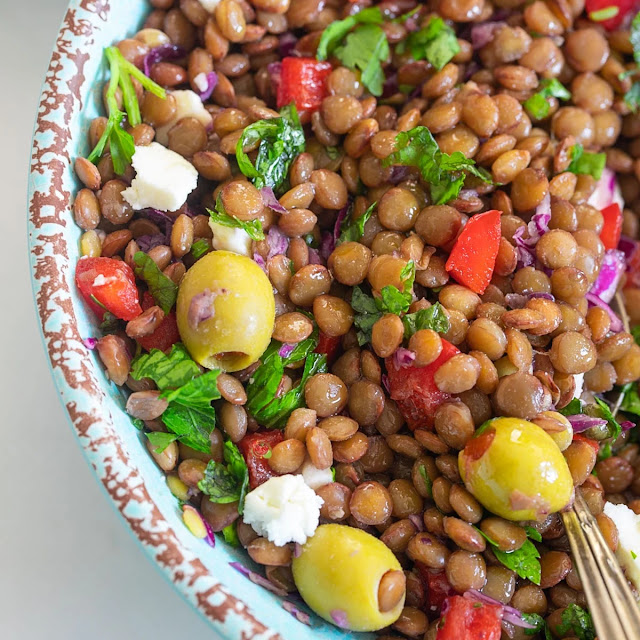Advertising
Advertising
Mediterranean cooking is eminent for its utilization of new fixings, energetic flavors, and medical advantages. Among its many delightful dishes, the Mediterranean Lentil Salad stands out as a versatile and nutritious option. This salad combines the earthy richness of lentils with the fresh, zesty flavors of Mediterranean vegetables and herbs, creating a dish that is as delicious as it is healthy.
The Origin of Mediterranean Lentil Salad
The Mediterranean Lentil Salad is a modern dish that draws inspiration from the rich culinary traditions of the Mediterranean region. This area, encompassing countries like Greece, Italy, Spain, Turkey, and parts of the Middle East and North Africa, is known for its use of fresh, wholesome ingredients and its emphasis on simple yet flavorful dishes. While the exact origin of the Mediterranean Lentil Salad is difficult to pinpoint, its components and flavors are deeply rooted in the region's culinary heritage.
Lentils in Mediterranean Cuisine
Lentils have been a staple in Mediterranean diets for thousands of years. Archaeological evidence suggests that lentils were cultivated in the Near East as early as 8000 BCE. These legumes have been valued for their nutritional benefits, affordability, and versatility. In many Mediterranean countries, lentils are used in soups, stews, and salads, making them a fundamental part of the local diet.
Salads and Fresh Vegetables
The Mediterranean diet is renowned for its abundant use of fresh vegetables, herbs, and olive oil. Salads are a common feature of Mediterranean meals, often incorporating a variety of seasonal produce. Ingredients like cucumbers, tomatoes, bell peppers, and red onions are frequently used, providing vibrant colors and refreshing flavors. The practice of combining these vegetables with legumes, grains, or proteins to create hearty salads is a natural extension of the region's culinary traditions.
Influence of Greek and Middle Eastern Cuisine
The Mediterranean Lentil Salad, as we know it today, is likely influenced by both Greek and Middle Eastern culinary practices. Greek cuisine, for instance, often includes lentils in dishes such as "fakes" (lentil soup) and various lentil salads. The use of feta cheese, olives, and lemon juice in the salad also reflects Greek culinary influences.
Middle Eastern cuisine, on the other hand, is known for its use of herbs like parsley and mint, as well as its emphasis on legumes. Dishes like "mujaddara" (a lentil and rice dish) and various mezze (small dishes) showcase the region's love for lentils and fresh, aromatic herbs. The combination of these elements in a salad form is a testament to the blending of culinary traditions across the Mediterranean.
Modern Adaptations
In contemporary cuisine, the Mediterranean Lentil Salad has become popular not only for its delicious taste but also for its health benefits. The modern recipe often incorporates elements from different Mediterranean countries, creating a dish that is both authentic and innovative. The use of extra virgin olive oil, fresh lemon juice, and a variety of vegetables and herbs makes this salad a perfect representation of the Mediterranean diet's principles.
The Origin of Mediterranean Lentil Salad
The Mediterranean Lentil Salad is a modern dish that draws inspiration from the rich culinary traditions of the Mediterranean region. This area, encompassing countries like Greece, Italy, Spain, Turkey, and parts of the Middle East and North Africa, is known for its use of fresh, wholesome ingredients and its emphasis on simple yet flavorful dishes. While the exact origin of the Mediterranean Lentil Salad is difficult to pinpoint, its components and flavors are deeply rooted in the region's culinary heritage.
Lentils in Mediterranean Cuisine
Lentils have been a staple in Mediterranean diets for thousands of years. Archaeological evidence suggests that lentils were cultivated in the Near East as early as 8000 BCE. These legumes have been valued for their nutritional benefits, affordability, and versatility. In many Mediterranean countries, lentils are used in soups, stews, and salads, making them a fundamental part of the local diet.
Salads and Fresh Vegetables
The Mediterranean diet is renowned for its abundant use of fresh vegetables, herbs, and olive oil. Salads are a common feature of Mediterranean meals, often incorporating a variety of seasonal produce. Ingredients like cucumbers, tomatoes, bell peppers, and red onions are frequently used, providing vibrant colors and refreshing flavors. The practice of combining these vegetables with legumes, grains, or proteins to create hearty salads is a natural extension of the region's culinary traditions.
Influence of Greek and Middle Eastern Cuisine
The Mediterranean Lentil Salad, as we know it today, is likely influenced by both Greek and Middle Eastern culinary practices. Greek cuisine, for instance, often includes lentils in dishes such as "fakes" (lentil soup) and various lentil salads. The use of feta cheese, olives, and lemon juice in the salad also reflects Greek culinary influences.
Middle Eastern cuisine, on the other hand, is known for its use of herbs like parsley and mint, as well as its emphasis on legumes. Dishes like "mujaddara" (a lentil and rice dish) and various mezze (small dishes) showcase the region's love for lentils and fresh, aromatic herbs. The combination of these elements in a salad form is a testament to the blending of culinary traditions across the Mediterranean.
Modern Adaptations
In contemporary cuisine, the Mediterranean Lentil Salad has become popular not only for its delicious taste but also for its health benefits. The modern recipe often incorporates elements from different Mediterranean countries, creating a dish that is both authentic and innovative. The use of extra virgin olive oil, fresh lemon juice, and a variety of vegetables and herbs makes this salad a perfect representation of the Mediterranean diet's principles.
Tips and Variations:
Tips:
1. Choose the Right Lentils: Use green or brown lentils, as they hold their shape well after cooking. Avoid red lentils, which tend to become mushy.
2. Properly Cook Lentils: Cook lentils until tender but not mushy. This typically takes about 20-25 minutes. Be sure to drain them well to avoid a watery salad.
3. Cool Lentils Completely: Let the lentils cool to room temperature before mixing them with other ingredients. This helps to maintain the salad's texture.
4. Use Fresh Ingredients: Opt for fresh vegetables and herbs for the best flavor and nutritional value. Organic produce can enhance the taste and health benefits.
5. Balance Flavors: Adjust the seasoning to taste. The combination of lemon juice, olive oil, salt, and pepper should be well-balanced. You can also add a pinch of cumin or paprika for extra depth.
6. Marinate for Better Flavor: Let the salad sit in the refrigerator for at least 30 minutes before serving. This permits the flavors to merge together and strengthen.
7. Serve at the Right Temperature: This salad is best served cold or at room temperature. Avoid serving it straight from the fridge for optimal flavor.
Variations:
1. Grain Addition: Add cooked grains such as quinoa, bulgur, or couscous to the salad for added texture and nutrition. This can make the salad more filling and provide a nice contrast to the lentils.
2. Protein Boost: For a more substantial meal, add a source of protein like grilled chicken, shrimp, or tofu. This transforms the salad into a hearty main course.
3. Vegan Version: To make the salad vegan, simply omit the feta cheese or substitute it with a plant-based cheese alternative. Dietary yeast can likewise be sprinkled on top for a messy character.
4. Different Herbs: Experiment with different herbs to change the flavor profile. Try adding basil, dill, cilantro, or oregano for a unique twist. Each herb brings its distinct taste and aroma.
5. Roasted Vegetables: Add roasted vegetables like zucchini, eggplant, or sweet potatoes for a warm and hearty version of the salad. Roasting brings out the natural sweetness and adds a lovely caramelized flavor.
6. Nuts and Seeds: Sprinkle toasted nuts or seeds, such as almonds, pine nuts, or sunflower seeds, over the salad for added crunch and nutrition.
7. Fruits: Incorporate fruits like diced apples, pomegranate seeds, or dried cranberries for a touch of sweetness and a burst of color.
8. Different Dressings: While the classic lemon and olive oil dressing is delicious, you can also experiment with other dressings. Try a tahini-based dressing, balsamic vinaigrette, or a yogurt-based dressing for a creamy texture.
9. Spice It Up: Add a bit of heat with chopped chili peppers, red pepper flakes, or a dash of hot sauce. This adds an exciting kick to the salad.
10. Use Different Cheeses: If you prefer, use different cheeses like goat cheese, ricotta salata, or mozzarella. Each cheese will offer a distinct flavor and texture.
Mediterranean cooking is eminent for its utilization of new fixings, energetic flavors, and medical advantages. Among its many delightful dishes, the Mediterranean Lentil Salad stands out as a versatile and nutritious option. This salad combines the earthy richness of lentils with the fresh, zesty flavors of Mediterranean vegetables and herbs, creating a dish that is as delicious as it is healthy.
Ingredients:
- - Lentils: 1 cup of green or brown lentils, rinsed and drained
- - Cucumbers: 1 large cucumber, diced
- - Cherry Tomatoes: 1 cup, halved
- - Red Onion: 1 little red onion, finely cleaved
- - Bell Peppers: 1 red and 1 yellow bell pepper, diced
- - Olives: 1/2 cup of Kalamata olives, pitted and sliced
- - Feta Cheese: 1/2 cup, crumbled (optional for a vegan version)
- - Parsley: 1/4 cup, finely chopped
- - Mint: 2 tablespoons, finely chopped
- - Garlic: 2 cloves, minced
- - Lemon Juice: Juice of 1 large lemon
- - Olive Oil: 1/4 cup extra virgin olive oil
- - Salt and Pepper: To taste
Instructions:
1. Cook the Lentils:
- In a medium saucepan, combine the lentils with 3 cups of water.
- Bring to a boil, then reduce the heat and let it simmer for about 20-25 minutes or until the lentils are tender but not mushy.
- Channel the lentils and let them cool totally.
2. Prepare the Vegetables:
- While the lentils are cooking, dice the cucumber, halve the cherry tomatoes, dice the bell peppers, and finely chop the red onion.
- Place the pre-arranged vegetables in a huge blending bowl.
3. Combine Ingredients:
- When the lentils have cooled, add them to the bowl with the vegetables.
- Add the sliced olives, crumbled feta cheese (if using), chopped parsley, mint, and minced garlic.
4. Make the Dressing:
- In a small bowl, whisk together the lemon juice, olive oil, salt, and pepper.
5. Dress the Salad:
Pour the dressing over the plate of mixed greens and throw everything together until all around consolidated.
6. Adjust Seasoning:
- Taste the salad and adjust the seasoning with additional salt, pepper, or lemon juice as needed.
7. Chill and Serve:
- For the best flavor, cover the plate of mixed greens and let it chill in the cooler for something like 30 minutes.
- Serve the salad cold or at room temperature.
Advertising


